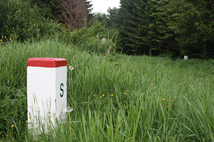Border: Poland-Slovakia
Date(s) of establishment: 1993 - current demarcation in 2005Length of border: 541 km
Regions concerned: Poland – Voivodeships of Silesia, Lesser Poland, Subcarpathia
Slovakia – Žilina region, Prešov region
European programme(s):
- Interreg IV A "Poland - Slovakia":
The programme on the Inforegio website
Presentation
Stretching over 514 km, the border between Poland and Slovakia begins in the west near the Polish village of Jaworzynka. It then follows a course winding from west to east, notably passing through the High Tatra mountains. It is within this mountain range that one can find Mount Rysy: a peculiarity of this border, this summit is seen to be the highest point in Poland even though the rest of the mountain range is almost totally in Slovakia. The border comes to an end in the East with the tripoint between the borders of Ukraine, Poland and Slovakia.
History
Between March and September 1939, Poland and Slovakia shared a border after the creation of the Slovak Republic, following the end of the Second Czechoslovak Republic. From 1945 to 1993, the border coincided with the Poland-Czechoslovakia border. On 1st January 1969, Czechoslovakia officially became a federal state, composed of two states, the Czech Republic and the Slovak Republic, fixing the Polish-Slovak border upon the dissolution of Czechoslovakia on 31 December 1992 and the independence of Slovakia on 1st January 1993. A number of minor modifications were made to the Polish-Slovak border in 2005.
This has been an internal border of the European Union since 2004 and an internal border of the Schengen Area since 2007.
Cross-border cooperation
Today, the two states have overcome these historical complications and their cross-border exchanges are extensive, notably with regard to the economy and culture.
Poland’s support in favour of the independence movement in Slovakia, the Slav culture common to the two populations and the prominence of Catholicism in the two countries are some of the factors that have strongly encouraged cross-border cooperation. This cooperation is nevertheless hampered by the lack of transport infrastructure, which greatly disadvantages any future development of the cross-border labour market.
In this context, the Interreg programme aims to improve accessibility to the border region, as well as its attractiveness, by promoting the development of tourism and by insisting on the protection of its natural and cultural heritage. It also aims to give a boost to partnerships concerning the labour market and schools, so that additional agreements can be made in the future.
The existing cross-border cooperation between the two countries is made visible within the Višegrad Group, of which they are both members, and by the development of Euroregions (Tatry Euroregion, Carpathian Euroregion) that has taken place since the partition of Czechoslovakia.
Territory projects and institutional bodies for cooperation
Cross-border cooperation at the regional level
Eurorégion BeskidyEurorégion Tatry
Eurorégion des Carpates
Groupe de Visegrad


